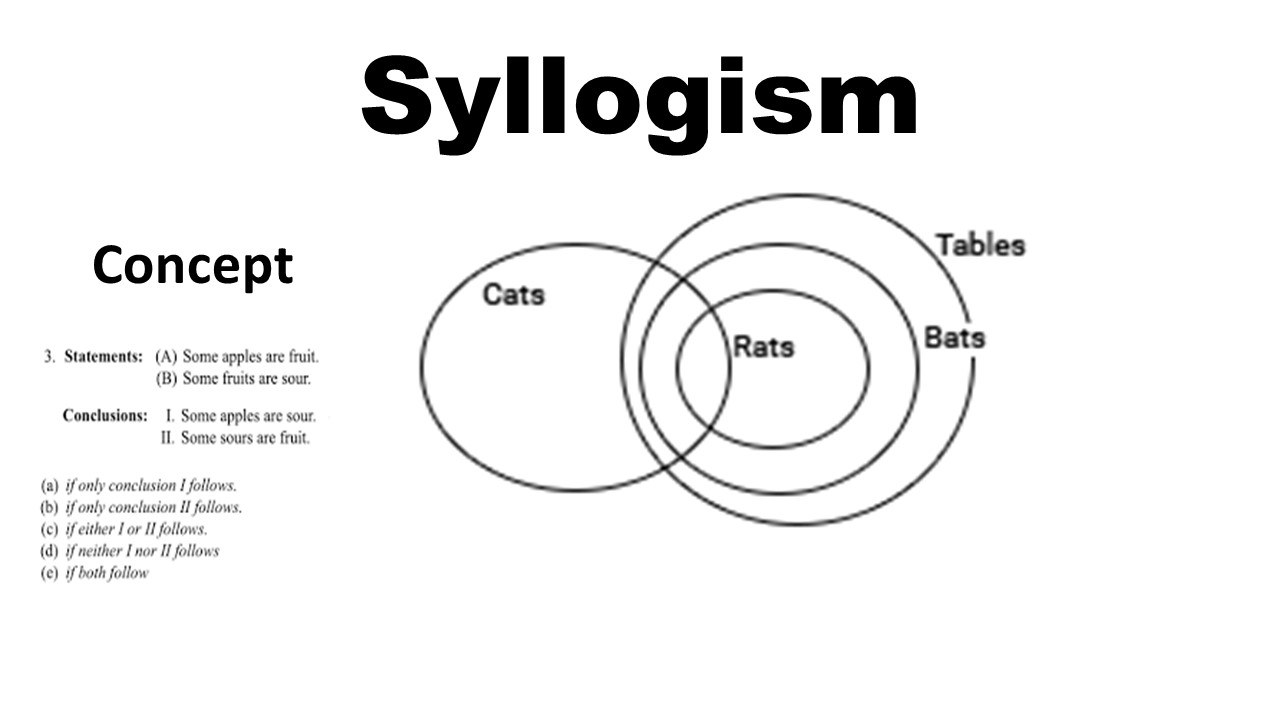
Syllogism Made Easy: Concepts, Types & Examples
Learn the fundamentals of syllogism, a key concept in logical reasoning. Understand types, structures, examples, and tips for solving syllogism questions effectively.
Syllogism: Concept and DetailsSyllogism is a form of deductive reasoning that involves drawing a conclusion from two or more premises that are asserted or assumed to be true.
Definition
A syllogism is a logical argument where a conclusion is inferred from two premises: a major premise and a minor premise.
Basic Structure:
- Major Premise: All A are B.
- Minor Premise: C is A.
- Conclusion: Therefore, C is B.
Example
Major Premise: All humans are mortal.
Minor Premise: Socrates is a human.
Conclusion: Therefore, Socrates is mortal.
Types of Syllogisms
- Categorical Syllogism
- Premises deal with categories or classes.
- Example:
- All dogs are animals.
- Some pets are dogs.
- Therefore, some pets are animals.
- Hypothetical Syllogism
- Contains “if…then…” statements.
- Example:
- If it rains, the ground will be wet.
- It is raining.
- Therefore, the ground is wet.
- Disjunctive Syllogism
- Contains “either…or…” statements.
- Example:
- Either the light is on or the room is dark.
- The light is on.
- Therefore, the room is not dark.
Important Concepts
Validity
A syllogism is valid if the conclusion logically follows from the premises.
Truth
A syllogism is true if the premises are factually correct.
A syllogism can be valid but not true if the premises are false.
Example:
- All fish can fly.
- A salmon is a fish.
- Therefore, a salmon can fly.
- Valid logic, but false premise.
Common Syllogism Keywords (used in competitive exams)
- All
- Some
- No
- None
- Only
- Not
- At least
- At most
Tips for Solving Syllogism Questions (Exams like SSC, Bank, etc.)
- Use Venn Diagrams: Draw circles to represent sets and visualize overlaps.
- Memorize Standard Patterns:
- All A are B = A is inside B.
- Some A are B = partial overlap.
- No A is B = no intersection.
- Check for Negative Conclusions carefully.
- Don’t assume anything beyond the premises.
Practice Example
Statements:
- All poets are writers.
- Some writers are singers.
Conclusions:
- Some poets are singers.
- All singers are writers.
Answer: Neither conclusion follows (can’t be deduced directly).
“Either-Or” Case in Syllogism (Logical Reasoning)
The “Either-Or” case is a special condition in syllogism questions where more than one conclusion seems possible, but only one can be true at a time — making them mutually exclusive.
Definition
In syllogism, an “Either-Or” conclusion is considered valid only when:
- Only one of the two conclusions can be true at a time, not both.
- Both conclusions are individually possible, but cannot be true together.
- Together they cover all logical possibilities, meaning if one is false, the other must be true.
Conditions for Valid “Either-Or”
| Condition | Requirement |
|---|---|
| Mutual Exclusivity | Both conclusions cannot be true at the same time |
| Possibility | Both conclusions can be true individually |
| Exhaustive | If one is false, the other must be true |
Example
Statements:
- All fruits are sweet.
- Some sweets are not fruits.
Conclusions:
- All sweets are fruits.
- Some sweets are not fruits.
Analysis:
- Both cannot be true at once (contradictory).
- One must be true.
- So, it is an Either Conclusion 1 or Conclusion 2 follows case.
Correct answer: Either 1 or 2 follows
Common Mistakes
- Thinking “either-or” applies when both conclusions are false — it doesn’t.
- Marking “either-or” when both conclusions can be true — invalid.
- Applying “either-or” to complementary statements like “some” and “all” without checking exclusivity.
Key Phrases Indicating Either-Or in Questions
- “Either conclusion I or II follows”
- “Only one can be true”
- “Mutually exclusive conclusions”
Pro Tip for Exams
- Use Venn diagrams to test individual truth and mutual exclusivity.
- Confirm that if one conclusion is false, the other is definitely true.
Statements:
- Some cups are plates.
- Some plates are bowls.
Conclusions:
- All cups are bowls.
- No cup is a bowl.
Answer Options:
A) Only I follows
B) Only II follows
C) Either I or II follows
D) Both follow
E) Neither follows
✅ Correct Answer: C) Either I or II follows
Explanation:
These are complementary and mutually exclusive. Both can’t be true together, but one must be. So it’s an “either-or” situation.Statements:
- All cars are vehicles.
- Some vehicles are bikes.
Conclusions:
- All bikes are cars.
- Some bikes are not cars.
Options:
A) Only conclusion 1 follows
B) Only conclusion 2 follows
C) Either conclusion 1 or 2 follows
D) Both conclusions follow
E) Neither conclusion followsStatements:
- No flowers are animals.
- Some animals are birds.
Conclusions:
- Some birds are flowers.
- No birds are flowers.
Options:
A) Only conclusion 1 follows
B) Only conclusion 2 follows
C) Either conclusion 1 or 2 follows
D) Both conclusions follow
E) Neither conclusion followsStatements:
- Some fruits are sweet.
- All sweets are candies.
Conclusions:
- Some candies are fruits.
- Some candies are not fruits.
Options:
A) Only conclusion 1 follows
B) Only conclusion 2 follows
C) Either conclusion 1 or 2 follows
D) Both conclusions follow
E) Neither conclusion follows



